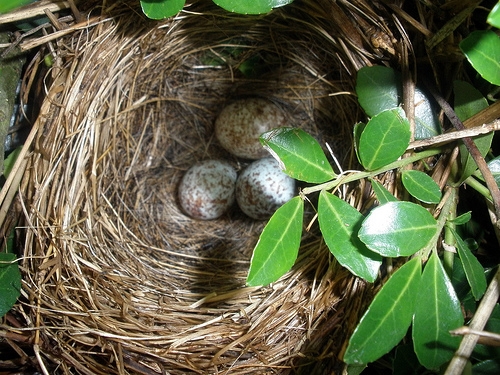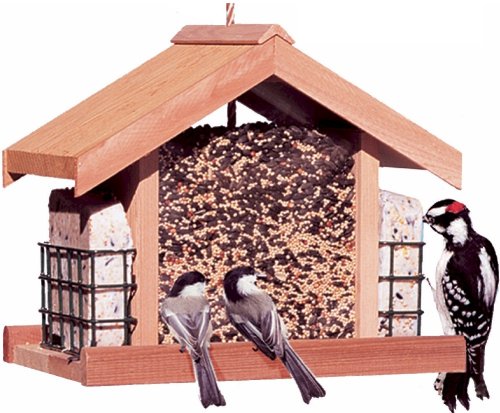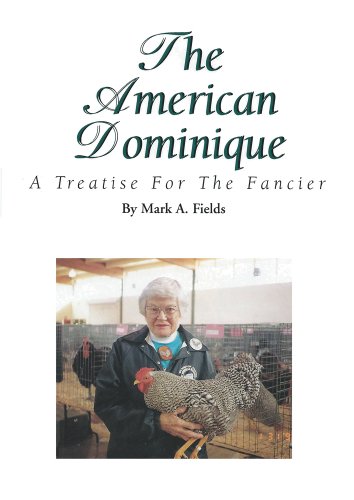
Pacific parrotlets, also known as Celestial parrotlets, are some of the smallest birds in captivity. In their wild home of the forests in Ecuador through Peru these birds are found in green with beautiful blue streaks on the males. In captivity many mutations have been bred. They are becoming very popular as pets for their spunky personality in a 4.5-5'' package. They are quiet, yet have the entertaining ability to talk making them popular dorm or apartment pets. They can be expected to live up to 2o years with proper care, so the birds do require thought and dedication before buying a pair. They are a common "Starter Bird" for breeders as they are sexually dimorphic, meaning males can visually be differentiated from females. This along with low price, easy care, and readiness to breed make it a great bird for both beginner and experienced aviculturists.
 Credit: Haileye
Credit: Haileye
To successfully breed parrotlets, you first must have a happy and healthy pair. Their main requirements include food, water, an appropriate cage, toys, and cleanliness.
Parrotlets consume more calories gram for gram than a blue and gold macaw. One can expect pairs to chow through the average seed cup daily. Their high metabolism is mostly due to their active nature. To support these active birds the proper amount of calories must be provided. These birds are not picky and will accept many foods. With a base of millet supplemented with other components they are easily pleased.
Supplements include fruits, vegetables, and possibly another calcium source. Calcium is extremely critical when it comes to breeding pairs. It is very important to provide with a source of calcium be it cuttlebone, mineral powder, or greens to prevent a fatal condition called egg binding.
One can expect to be refilling food and water daily while a pair is not breeding, and up to 3 times when raising babies. Another adjustment of diet when breeding is introducing egg-food. This is powdered food that is moistened before served. It provides extra vitamins for the babies while being easier for the parents to regurgitate.
To house a breeding pair the ideal cage size is 18"x18''x36''. It is recommended to spend as much space and money on a cage as one can afford. Another factor to consider is housing the babies. The male of a breeding pair will often become aggressive as chicks reach maturity. It is critical to have a way of seperating the male from the chicks and the mother until the babies can safely eat on their own and be moved to another cage. This means having at least one spare cage on hand for temporary housing.
Preferably a nesting box can be hung on the outside of the cage for accessibility and to avoid sparing the space of the birds. The nesting box should be a standard parakeet size up to a cockatiel size. These can be found at the local petstore. Caution is advized while choosing a material for the bottom. It is critical that one use non-toxic bedding. A layer an inch or so thick should be provided on the bottom of the box. Be sure to replace this as parents toss it out.
A wide variety of perches and toys should be provided. This will prevent foot problems and problems associated with boredom. Parrotlets are intelligent birds and are indeed parrots. Don't let their size fool you! With their antics and energy they need many outlets. Paper, unused shoe laces, and swings are popular among them. They are avid chewers and will bite holes into material in reach.
Papers should be provided at the bottom of the cage and changed often. An alternate option is bedding. This will require a tray a few inches deep to prevent spillage. It is important to remove the grate of the breeding cage if babies are fledged before they are old enough to perch. A seed guard helps keep seed scatter to a minimum. These are available in plastic or mesh as pictured.
Pacific parrotlets have no designated breeding season, but will generally breed once a nesting box is introduced. They lay clutches of 4-6 eggs on average with high fertility rates. These eggs are laid every other day. A hen may or may not sit on the eggs immediately. Once she does developement begins. Chicks will hatch every other in the order they were laid after the hen has begun sitting on them. Generally pacifics are very good parents, so there is not much worry of missteps. They are more likely to be aggressive while raising babies. It is important not to make changes to their environment while they are rearing their young.
Another reason these birds are popular to breed is that unlike nearly any other parrent they are tolerant of co-parenting. This is a process that results in tame babies without hand-feeding. Once babies are 5 to 8 days old they can cautiously be taken out of the nest box to socialize with humans. If done frequently the babies will likely be as tame as any hand-tamed birds.
 Exploretrip Partners With Take Trips Guard To Deliver Travel Insurance
Any most famous elegance in the metropolitan area is none
Exploretrip Partners With Take Trips Guard To Deliver Travel Insurance
Any most famous elegance in the metropolitan area is none
 How to Help a Bird That Flew Into the Window
How to Help a Bird That Flew Into the Window
How to Help a Bird That Flew Into the Window
How to Help a Bird That Flew Into the Window
 Bird Mites Treatment
Bird Mites Treatment
Bird Mites Treatm
Bird Mites Treatment
Bird Mites Treatment
Bird Mites Treatm
 Learn what you need to Breed Indian Ringneck Parrots
Birds are beautifulThere are so many beautiful
Learn what you need to Breed Indian Ringneck Parrots
Birds are beautifulThere are so many beautiful
 The Dominique Chicken
Poultry BreedsThe DominiqueT
The Dominique Chicken
Poultry BreedsThe DominiqueT
Copyright © 2005-2016 Pet Information All Rights Reserved
Contact us: www162date@outlook.com